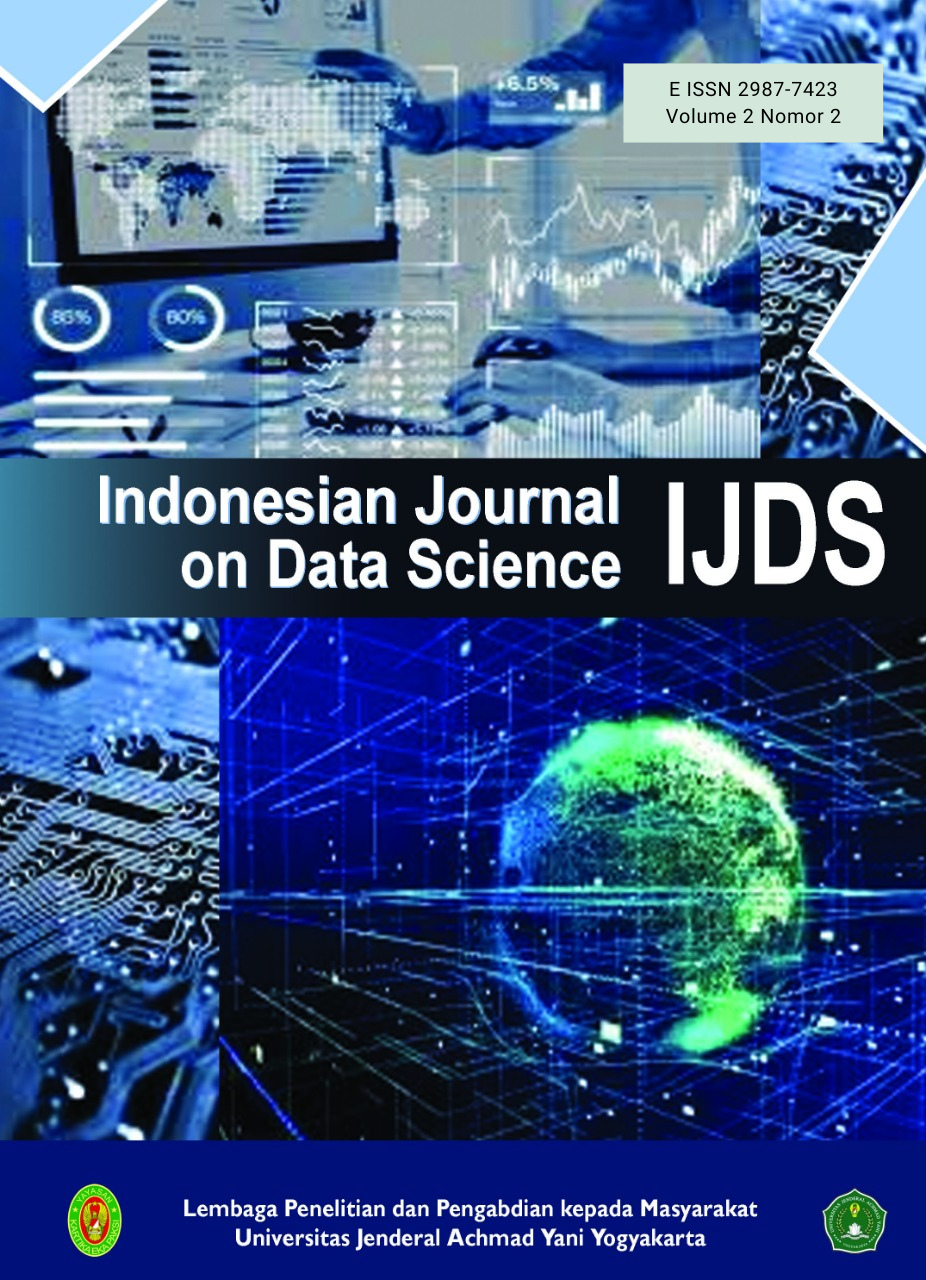ANALISIS PERSEPSI PUBLIK DI MEDIA SOSIAL TERHADAP PRODUK HALAL DI INDONESIA MENGGUNAKAN TEXT MINING
DOI:
https://doi.org/10.30989/ijds.v2i2.1487Kata Kunci:
Produk Halal, Media Sosial, Text Mining, Pemodelan Topik, Analisis SentimenAbstrak
Jaminan status halal suatu produk sangat penting bagi konsumen Muslim, terutama di Indonesia, negara dengan mayoritas penduduk Muslim terbesar di dunia. Pemerintah, melalui Kementerian Agama, telah menerapkan sertifikasi halal untuk menjamin validitas produk. Namun, penerapan sistem jaminan halal tetap kontroversial, dengan sebagian melihatnya sebagai upaya untuk keuntungan pemerintah, terutama Kementerian Agama melalui MUI (Majelis Ulama Indonesia). Sentimen negatif dari kelompok yang berlawanan dapat berpotensi eskalatif dan memengaruhi individu atau komunitas lain jika tidak ditangani dengan tepat. Salah satu langkah preventif adalah mempromosikan edukasi dan kesadaran produk halal melalui media digital, khususnya media sosial. Mengingat penggunaan media sosial yang luas, terutama di kalangan milenial, media sosial dapat menjadi platform yang efektif dan hemat biaya untuk edukasi dan promosi. Upaya edukasi melalui media sosial memerlukan strategi khusus untuk memastikan diseminasi informasi yang optimal sesuai harapan. Memahami pola dan karakteristik konten serta konteks sosio-kultural pengguna media sosial sangat penting. Pemahaman ini dapat dicapai melalui analisis komprehensif terhadap beragam dan melimpahnya konten yang dihasilkan pengguna di platform media sosial. Oleh karena itu, penelitian ini mengusulkan metode berbasis text mining untuk mengembangkan kerangka kerja dalam memahami karakteristik dan dinamika percakapan publik mengenai produk halal di media sosial.
Referensi
[2] S. Chairunnisyah, "Peran Majelis Ulama Indonesia Dalam Menerbitkan Sertifikat Halal Pada Produk Makanan Dan Kosmetika," EduTech: Jurnal Ilmu Pendidikan dan Ilmu Sosial, vol. 3, no. 2, 2017.
[3] T. N. Ma'rifat and M. Sari, "Penerapan Sistem Jaminan Halal Pada UKM Bidang Olahan Pangan Hewani," Khadimul Ummah, vol. 1, no. 1, 2017.
[4] F. Farhan and B. Sutikno, "The acceptance of halal food products among Non-Muslim consumers in Indonesia," Journal of International Food & Agribusiness Marketing, vol. 36, no. 2, pp. 125–146, 2024.
[5] R. Agusiady, D. Saepudin, and Z. Aripin, "The influence of social media communication on consumer perceptions of brands and purchase intentions in the pandemic and post-pandemic era: an analytical study," Journal of Jabar Economic Society Networking Forum, vol. 1, no. 2, pp. 16–30, 2024.
[6] F. A. Hudaefi and I. Jaswir, "Halal governance in Indonesia: Theory, current practices, and related issues," Journal of Islamic Monetary Economics and Finance, vol. 5, no. 1, pp. 89–116, 2019.
[7] H. Zhu, H. Wu, J. Cao, G. Fu, and H. Li, "Information dissemination model for social media with constant updates," Physica A: Statistical Mechanics and Its Applications, vol. 502, pp. 469–482, 2018.
[8] H. Jung and B. G. Lee, "Research trends in text mining: Semantic network and main path analysis of selected journals," Expert Systems with Applications, vol. 162, 113851, 2020.
[9] A. F. Hidayatullah and M. R. Ma’arif, "Pre-processing tasks in Indonesian Twitter messages," in Journal of Physics: Conference Series, vol. 801, no. 1, p. 012072, 2017.
[10] I. Vayansky and S. A. Kumar, "A review of topic modeling methods," Information Systems, vol. 94, 101582, 2020.
[11] D. M. Blei, A. Y. Ng, and M. I. Jordan, "Latent dirichlet allocation," Journal of Machine Learning Research, vol. 3, pp. 993–1022, Jan. 2003.
[12] U. Chauhan and A. Shah, "Topic modeling using latent Dirichlet allocation: A survey," ACM Computing Surveys (CSUR), vol. 54, no. 7, pp. 1–35, 2021.
[13] M. Wankhade, A. C. S. Rao, and C. Kulkarni, "A survey on sentiment analysis methods, applications, and challenges," Artificial Intelligence Review, vol. 55, no. 7, pp. 5731–5780, 2022.
[14] R. Ferdiana, F. Jatmiko, D. D. Purwanti, A. S. T. Ayu, and W. F. Dicka, "Dataset Indonesia untuk Analisis Sentimen," Jurnal Nasional Teknik Elektro dan Teknologi Informasi (JNTETI), vol. 8, no. 4, pp. 334–339, 2019.
[15] C. Hutto and E. Gilbert, "Vader: A parsimonious rule-based model for sentiment analysis of social media text," in Proceedings of the International AAAI Conference on Web and Social Media, vol. 8, no. 1, pp. 216–225, 2014.
Unduhan
Diterbitkan
Terbitan
Bagian
Citation Check
Lisensi
Hak Cipta (c) 2025 Muhammad Rifqi Maarif

Artikel ini berlisensiCreative Commons Attribution-ShareAlike 4.0 International License.
Indonesian Journal On Data Science allows readers to read, download, copy, distribute, print, search, or link to its articles' full texts and allows readers to use them for any other lawful purpose. The journal allows the author(s) to hold the copyright without restrictions. Finally, the journal allows the author(s) to retain publishing rights without restrictions
- Authors are allowed to archive their submitted articles in an open access repository
- Authors are allowed to archive the final published article in an open access repository with an acknowledgment of its initial publication in this journal

This work is licensed under a Creative Commons Attribution-ShareAlike 4.0 Generic License.



